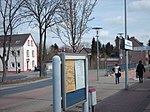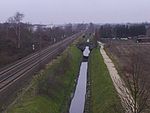Kleinenbroich station
1853 establishments in PrussiaBuildings and structures in Rhein-Kreis NeussNorth Rhine-Westphalia railway station stubsRailway stations in Germany opened in 1853Rhine-Ruhr S-Bahn stations ... and 2 more
Rhine-Ruhr S-Bahn stubsS8 (Rhine-Ruhr S-Bahn)

Kleinenbroich station is a through station in the town of Korschenbroich in the German state of North Rhine-Westphalia. The station was opened on 17 January 1853 on the Mönchengladbach–Düsseldorf railway opened between Mönchengladbach and Neuss by the Aachen-Düsseldorf-Ruhrort Railway Company on 16 December 1852. It has two platform tracks and it is classified by Deutsche Bahn as a category 5 station.The station is served by Rhine-Ruhr S-Bahn lines S 8 between Mönchengladbach and Wuppertal-Oberbarmen or Hagen every 20 minutes.
Excerpt from the Wikipedia article Kleinenbroich station (License: CC BY-SA 3.0, Authors, Images).Kleinenbroich station
Ladestraße,
Geographical coordinates (GPS) Address Website Nearby Places Show on map
Geographical coordinates (GPS)
| Latitude | Longitude |
|---|---|
| N 51.195354 ° | E 6.549756 ° |
Address
Centershop
Ladestraße 4
41352 , Kleinenbroich
North Rhine-Westphalia, Germany
Open on Google Maps











